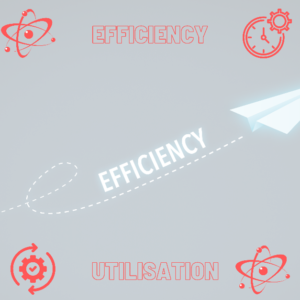There are lots of ways of setting your labour rate.
This training topic looks at one method and the implications that could have for your business.
Using a basic formula based on your fixed costs.
However, we will also consider differentiated labour rates.
Using different labour rates for the different services you provide.
Are they confusing or do you already use them?
Finally, dealing with inflation and price increases while still adding value.setting
Calculating or Setting your labour rate
Many garages base their labour rate on what’s happening around them.
Based on what their competitors and other garages are charging.
This biases what they think they can charge.
If they feel they are slightly better than average, they might put their labour rate slightly above the local average.
Or garages set their labour rate, to try and attract customers as a loss leader.
This can be very tempting if you’re a new business, setting your labour rate lower to attract customers.
But I urge you not to, I urge you to follow the formula.
Some businesses suggest that the local rate is all people will pay.
That you cannot increase your charges.
That there is an artificial glass ceiling on the local labour rate.
This is holding a lot of businesses back, and it stops them from being profitable.
These self-limiting beliefs are damaging.
What you should do is calculate your labour rate based on your figures.
The Formula for calculating your labour rate
Labour Rate equals
Your Fixed Costs
Divided by
Number of Hours Worked multiplied by the Profit % Required
How did I come up with this list?
Fixed costs can be slightly different depending on your accountant, different accounting software packages and garage management systems may give you slightly different fixed costs.
This is because some include wages and salaries, and some do not.
In this case, Fixed costs must include the wages and salaries of your staff.
The time period be it weekly, monthly, or annually, doesn’t matter.
You should end up with the same number at the end as long as you are looking at the fixed costs over the same period as the hours worked.
For this example, we have broken it down to weekly.
Weekly fixed costs / hours worked that week
That basic figure is then multiplied by the profit % you want.
Typically you want a profit margin of somewhere between 5 and 20%.
You can have more. There is nothing stopping you.
In fact, the more, the better as far as I’m concerned. But there is a limit.
It’s based on your competition, the pricing structures locally, and the financial climate in your local area.
Is it an affluent area? Or is not so affluent?
This will dictate the maximum profit % but not the basic rate.
When considering the hours worked, you need to take into account the number of hours you work per week and the number of weeks you work per year.
Allowing for holidays, take into account any closures and get, the number of weeks and hours worked as an average for the year, then the period you have chosen to calculate.
In this case the weekly average.
Remember, the number of hours is multiplied by the number of techs and by your efficiency.

The efficiency of a typical independent garage is somewhere between 50 and 75%.
If you use 62.5% halfway it will put you in the ballpark.
But remember, if you want to improve your profit, improve your efficiency or reduce your costs.
It’s as simple as that.
Don’t go penny-pinching, don’t cut quality cut costs.
Once you know your fixed costs, and the number of hours worked.
Hours worked is based on the number of hours we work in a given period, which is typically a 40 hour week if we start there, multiply by the number of techs multiplied by the efficiency, remember to take into account holidays and sick days.
The Atomic Success Program uses a spreadsheet, but if you just want to get to see if your current labour rate is covering your costs, you can just use this formula.
Once you have calculated the basic rate you can multiply it by the profit % you want.
A lot of labour rate calculators don’t add the profit bit.
I can understand why, but in my opinion, we want to make a profit.
So in this example, the business has fixed costs of £360,000 per year.
Broken down to per week by dividing by 52 equals £6,923 per week of fixed costs.
Hours worked equals
4 technicians x 40 = 160 x the efficiency =0.625 =100 hours
The reason I’ve done that is to make the maths nice and simple.
Fixed costs / hours worked = £6923 / 100
Therefore the basic hourly rate (before profit) is £69.23.
They want a 10% profit, £69.23 x 1.1 to give you 10% profit.
Now the labour rate is £76.15 plus VAT.
Including VAT the labour rate is £91.38 which will cover all of the fixed costs and provide a small profit of 10% as long as they maintain an efficiency of 62.5%
That is interesting because that rate is probably quite high compared to what a lot of people are charging.
The average UK labour rate was £47.47 in 2020 according to the Independent Garage Association. It does vary from region to region because the local economies do influence it. So it could be higher in the southeast than it is in South Wales.
It’s just the way it is. Local economies are slightly different, but I’m going to guess most people are charging somewhere between £50 and £65.
If this fictitious garage was charging £50- £65 that would not be covering its fixed costs with the one thing that it is in their control, which is its labour.
That business is probably only surviving or only making a profit based on the parts sales.
Too many independent garages find themselves in this position, and the jump from the current labour rate to the rate needed to cover the fixed costs is often quite a big gap.
In this case, it is between £11- £26 an hour, which might be difficult to put up with all in one go.

Differentiated Labour Rates
Should we have the same labour rate for everything?
Should we just have one labour rate?
Or can we, and should we have a different labour rate for our diagnostic services, our air con services and our MOT’s?
If you do MOT’s, you already have a different labour rate for your MOT.
It would be very unusual for your labour rate to be based on your MOT fee.
If the average MOT takes about three-quarters of an hour.
The MOT fee is £54.85 divide by 0.75 = £73.13 per hour.
That is what the government consider an independent garage that offers some sort of specialist service should be charging for its labour.
But they set that 12 years ago.
If this garage was £65 +VAT = £78 quid, the MOT is £73.13 +VAT = £87.76 that is interesting, the government rate is higher than the national average.
Are differentiated rates confusing?
I don’t think they are.
Different services should attract a different fee, but that’s down to the individual business owner to work out.
You already have differentiated labour rates based on the services that you provide if you carry out an MOT.
So why shouldn’t services that require higher levels of skill and higher levels of investment in the equipment attract a higher labour rate?
The higher labour rate allows you to reinvest in the business to ensure you have the latest equipment, information systems, et cetera, to do that job.
That is what the labour rate is for.
It covers the fixed costs plus a small profit.
If the fixed costs for doing a certain type of work are higher, why not charge more?
You can work it out by breaking out different costs for different jobs.
The costs of doing business for each individual item if you wanted to, but that’s up to you.
Differentiated labour rates are not a bad idea. In fact, they’re essential.

Inflation
Is a hot topic at the moment.
Inflation has resulted in price increases to maybe your rent, water rates, gas, electric, everything is going up, which means ultimately you have to pass that cost on to your customers.
However, if you increase prices, do you need to add value?
I’d argue you do. However, there is a quid pro quo here, if the cost to you is higher, then the cost to your customer should be higher.
How do you pass that cost on?
How do you deal with inflation within your business?
I’ve done some training on something called net present value, which basically states that a pound in your pocket today is worth less tomorrow.
A pound in your pocket today isn’t worth a pound tomorrow due to inflation.
The average inflation rate in the UK over the last 10 years or so has been about 2.6%.
As a business, we put our prices up by around about 3% every year.
This means the MOT fee would now be £73.76 due to inflation.
Now I wouldn’t mind that, doing mots for £74.
But that’s what inflation has done to the MOT price.
Back in 2010 when the fee was set that £54.85 represents £73.76 today.
That’s the difference.
So in effect, the government not putting increasing the fee in line with inflation is costing you money.

How do you deal with inflation?
Either increase your rate incrementally every year or put it up by a big amount every 5-10 years.
When you start feeling the pinch, I know what I’d rather do.
I know what customers are more comfortable with, but it’s your decision.
If you do end up putting it up by a big amount because you haven’t kept up with inflation.
Because inflation was relatively low at 2.6% you have left it.
Undoubtedly, you will feel the need to add value, because you can’t just put up your labour rate by that amount without anyone noticing.
You must add some value.
Every transaction must be a fair exchange.
So you must think about how you set your labour rate so that it covers your costs because that’s the only thing we’re in control of within our business.
We want the profit on the parts that we sell to be cream.
Too many independent garages are surviving, or maybe not even surviving on their parts profit.
We need to ensure that we cover our costs with our labour rate plus a small profit.
Then the business should also be making money on the parts, the shop if you like part of the business.

